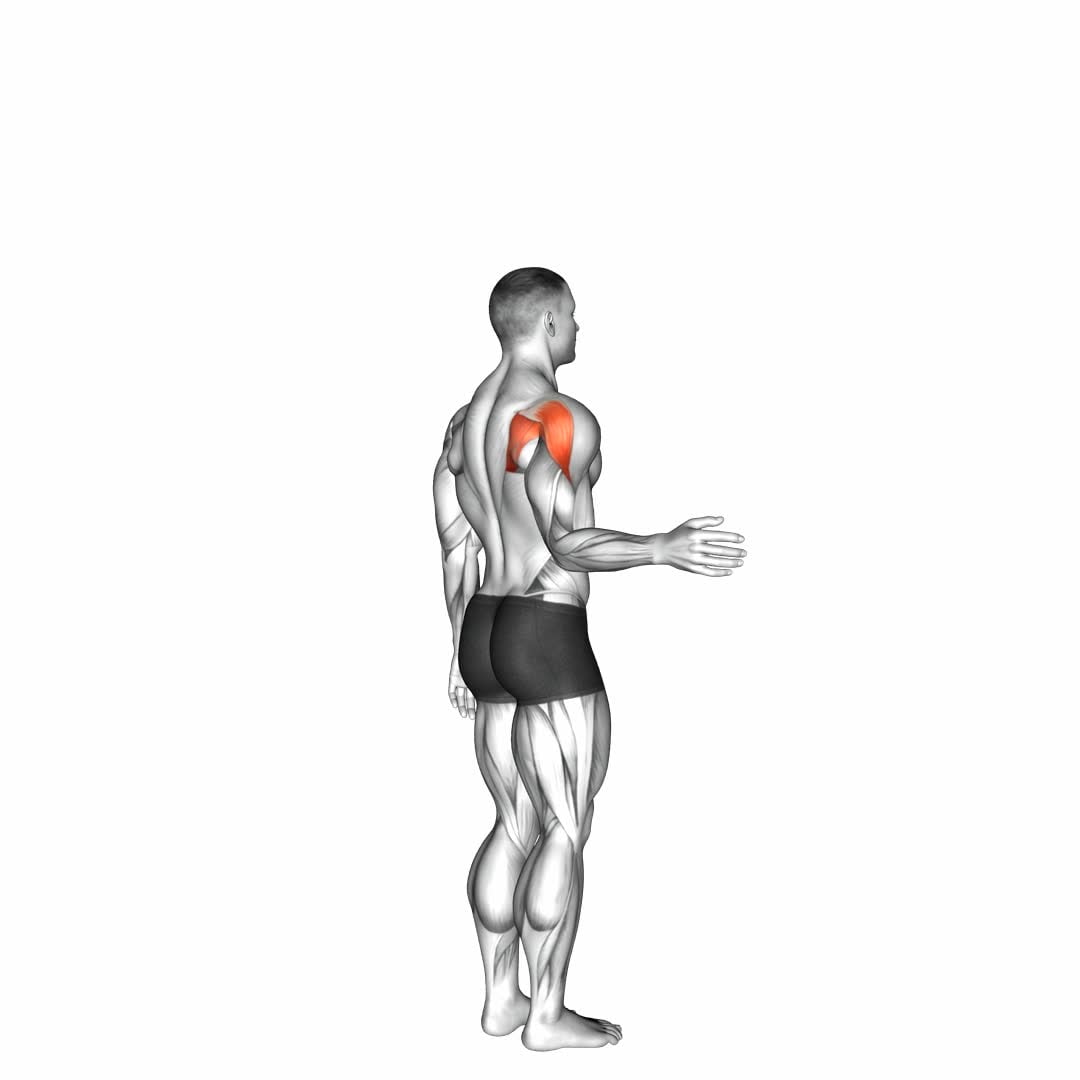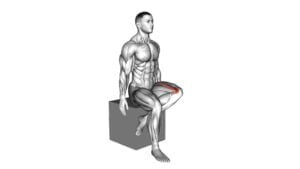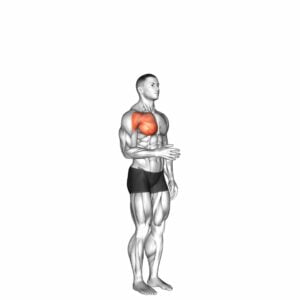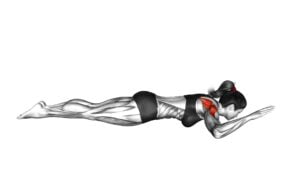Shoulder – Lateral Rotation (External Rotation) – Video Exercise Guide & Tips

Looking to improve your shoulder mobility and strengthen your rotator cuff muscles?
Watch This Exercise Video
In this video exercise guide, we'll walk you through the proper technique for shoulder lateral rotation (external rotation) exercises.
Avoid common mistakes, learn advanced variations, and discover tips for incorporating lateral rotation into your workout routine.
Get ready to enhance your shoulder strength and flexibility with this comprehensive guide.
Let's get started!
Key Takeaways
- Shoulder lateral rotation strengthens and stabilizes shoulder joint muscles.
- It targets rotator cuff muscles for improved mobility and stability.
- Performing the exercise with proper form and technique is crucial to avoid injury.
- Using resistance bands, dumbbells, or cable machines can enhance the effectiveness of lateral rotation exercises.
Benefits of Shoulder Lateral Rotation
One major benefit of shoulder lateral rotation is that it strengthens and stabilizes the muscles in your shoulder joint. This exercise specifically targets the rotator cuff muscles, which play a crucial role in shoulder mobility and stability. The rotator cuff is a group of muscles and tendons that surround the shoulder joint, allowing for smooth and controlled movements.
By regularly performing shoulder lateral rotation exercises, you can enhance the strength and endurance of your rotator cuff muscles. This can help prevent injuries, such as rotator cuff tears or impingement, which are common among athletes and individuals who engage in repetitive overhead activities.
Additionally, shoulder lateral rotation exercises improve shoulder mobility. These movements involve externally rotating the shoulder, which helps to stretch and lengthen the muscles and tendons around the joint. This increased range of motion can be beneficial for various activities, such as reaching, throwing, and lifting.
Incorporating shoulder lateral rotation exercises into your workout routine can provide numerous benefits. Not only will it enhance the strength and stability of your shoulder joint, but it will also improve your overall shoulder mobility, allowing you to move more freely and perform daily activities with ease.
Common Mistakes to Avoid
To avoid compromising the effectiveness of your shoulder lateral rotation exercises and to maximize the benefits for your shoulder joint, it's important to be aware of common mistakes to avoid. Here are three common mistakes to watch out for when performing shoulder lateral rotation exercises for injury prevention:
- Using too much weight: One of the most common mistakes is using too much weight, which can put excessive strain on your shoulder joint. Start with a lighter weight and gradually increase the resistance as your strength improves.
- Poor form and technique: Another mistake is performing the exercise with poor form and technique. Avoid swinging or jerking the weight, as this can lead to injury. Keep your movements controlled and focus on isolating the shoulder muscles.
- Neglecting proper warm-up: Many people overlook the importance of warming up before starting their shoulder lateral rotation exercises. Skipping the warm-up can increase the risk of injury. Prioritize a dynamic warm-up that includes shoulder mobility exercises and stretches to prepare your muscles for the workout.
Essential Equipment for Lateral Rotation Exercises
To effectively perform shoulder lateral rotation exercises, you'll need essential equipment that supports proper form and targets the shoulder muscles. Having the proper equipment for lateral rotation is crucial to ensure that you can perform the exercise safely and effectively.
One of the most common pieces of equipment used for lateral rotation exercises is resistance bands. These bands come in different levels of resistance, allowing you to adjust the intensity of the exercise according to your fitness level. They're lightweight, portable, and versatile, making them ideal for home workouts or when you're on the go.
Another option for lateral rotation exercise equipment is dumbbells. Dumbbells provide a greater range of motion and allow for more resistance compared to resistance bands. They come in various weights, so you can choose the appropriate weight for your fitness level. Dumbbells also provide stability and balance during the exercise, helping you maintain proper form.
Lastly, cable machines or pulley systems can also be used for lateral rotation exercises. These machines allow for a controlled and smooth movement, targeting the shoulder muscles effectively. They provide constant tension throughout the exercise, making it more challenging and beneficial for muscle growth.
In conclusion, the proper equipment for lateral rotation exercises includes resistance bands, dumbbells, and cable machines. These equipment options provide different levels of resistance and range of motion, allowing you to customize your workout and target the shoulder muscles effectively.
Now let's move on to discussing the proper technique for shoulder lateral rotation.
Proper Technique for Shoulder Lateral Rotation
To perform shoulder lateral rotation correctly, position yourself with your arm at your side and your elbow bent at a 90-degree angle. This exercise is beneficial for improving shoulder mobility and preventing injuries. Here's a step-by-step guide to executing the proper technique:
- Stand with your feet shoulder-width apart and maintain good posture.
- Hold a resistance band or a light dumbbell in your hand with your palm facing inward.
- Keep your upper arm close to your side throughout the movement.
- Slowly rotate your forearm away from your body, maintaining control and a smooth motion.
- Pause briefly at the end of the rotation.
- Slowly return to the starting position, ensuring that your forearm remains close to your body.
- Repeat for the desired number of repetitions.
- Remember to breathe evenly and avoid any jerky or sudden movements.
By following these guidelines, you'll maximize the benefits of shoulder lateral rotation exercises.
This exercise is particularly effective for strengthening the muscles involved in external rotation, which can help improve shoulder stability and reduce the risk of injuries. Incorporate this exercise into your regular workout routine to enhance shoulder mobility and prevent potential issues in the future.
Advanced Variations of Lateral Rotation Exercises
Explore advanced variations of lateral rotation exercises to further challenge and strengthen your shoulder muscles. Adding advanced variations to your workout routine can help you take your shoulder strength to the next level. These exercises target the muscles involved in lateral rotation, such as the infraspinatus and teres minor.
One advanced variation is the standing lateral rotation with resistance bands. Attach a resistance band to a fixed object at waist height. Stand with your side facing the anchor point and hold the band with your arm extended in front of you. Rotate your arm away from the anchor point, maintaining control and resistance throughout the movement. This exercise increases the challenge by adding resistance to the lateral rotation movement.
Another advanced variation is the seated lateral rotation with dumbbells. Sit on a bench with a dumbbell in each hand, palms facing up. Start with your elbows bent at 90 degrees and your upper arms parallel to the ground. Rotate your forearms outward, keeping your upper arms stationary. This exercise targets the muscles responsible for lateral rotation and also engages your core for stability.
Incorporating these advanced variations into your workout routine can help you continue to progress and challenge your shoulder muscles. Remember to start with lighter weights and gradually increase the resistance as you become stronger. Always maintain proper form and listen to your body to avoid injury.
Tips for Incorporating Lateral Rotation Into Your Workout Routine
When incorporating lateral rotation into your workout routine, it's important to focus on maintaining proper form throughout the exercise. This includes keeping your shoulder stabilized and engaging the muscles of the rotator cuff.
Proper Form for Rotation
Incorporate proper form for lateral rotation to optimize your shoulder workout routine. To ensure correct technique and maximize muscle activation, follow these tips:
- Stand with your feet shoulder-width apart and hold a dumbbell in your hand.
- Keep your elbow close to your side and bend your arm at a 90-degree angle.
- Begin the movement by rotating your forearm outward, away from your body.
- Keep your upper arm stationary throughout the exercise.
- Slowly return to the starting position, controlling the motion.
Engage your core and maintain proper posture throughout.
Perform the exercise in a controlled manner, focusing on the targeted muscles.
Start with a lighter weight and gradually increase as you become more comfortable and confident.
Incorporate lateral rotation exercises into your shoulder workout routine 2-3 times per week for optimal results.
Benefits of Lateral Rotation
To maximize your shoulder workout routine, incorporate lateral rotation into your routine to experience the benefits of increased shoulder stability and improved functional movement. Lateral rotation exercises target the muscles responsible for external rotation, such as the infraspinatus and teres minor. By strengthening these muscles, you can improve your shoulder mobility and reduce the risk of injuries.
Increased shoulder stability is crucial for athletes and individuals who engage in activities that require overhead movements, such as throwing, swimming, or weightlifting. By incorporating lateral rotation exercises into your workout routine, you can enhance your overall shoulder strength and prevent common shoulder injuries, such as rotator cuff tears or impingement.
Don't forget to warm up before performing these exercises and start with lighter weights to ensure proper form and technique.
Frequently Asked Questions
Can Shoulder Lateral Rotation Exercises Help With Shoulder Impingement?
Shoulder lateral rotation exercises can be beneficial for shoulder impingement. By incorporating these exercises into your routine, you can improve shoulder mobility and reduce the risk of impingement.
Athletes especially can benefit from shoulder lateral rotation exercises as they help strengthen the muscles around the shoulder joint, enhancing stability and preventing injuries.
These exercises target specific muscles involved in the lateral rotation of the shoulder, allowing for better range of motion and overall shoulder health.
How Often Should I Perform Shoulder Lateral Rotation Exercises?
To experience the benefits of shoulder lateral rotation exercises, it's important to perform them regularly. Incorporating these exercises into your routine can help improve shoulder mobility, strengthen the rotator cuff muscles, and prevent injuries.
The best shoulder lateral rotation exercises include resistance band external rotations and dumbbell lateral raises. Aim to do these exercises at least 2-3 times a week, with a day of rest in between to allow your muscles to recover.
Can Shoulder Lateral Rotation Exercises Help Improve Posture?
Shoulder lateral rotation exercises can definitely help improve your posture. By engaging the muscles responsible for external rotation, you can strengthen your upper body and promote better alignment.
These exercises not only target the shoulder muscles but also work your core stability, which is crucial for maintaining proper posture.
Are There Any Modifications for Individuals With Shoulder Injuries or Limitations?
If you have a shoulder injury or limitations, there are modifications you can make to shoulder lateral rotation exercises. These modifications can help you work within your limitations and avoid further injury.
It's important to consult with a healthcare professional or a qualified trainer who can assess your condition and provide appropriate modifications. By making these modifications, you can still engage in shoulder exercises that are safe and effective for your specific needs.
Can Shoulder Lateral Rotation Exercises Be Done Without Any Equipment?
To work on shoulder lateral rotation without equipment, try alternative exercises like the doorway stretch or the towel stretch. These exercises can help improve flexibility and strengthen the muscles involved in shoulder rotation.
Incorporating shoulder lateral rotation exercises into your daily routine brings several benefits, such as increasing range of motion, reducing the risk of injury, and improving overall shoulder function.
Make sure to consult with a healthcare professional before starting any exercise program, especially if you have any shoulder injuries or limitations.
Conclusion
Incorporating shoulder lateral rotation exercises into your workout routine can provide numerous benefits, such as improving shoulder mobility and strengthening the rotator cuff muscles.
By using proper technique and avoiding common mistakes, you can maximize the effectiveness of these exercises.
Additionally, advanced variations can challenge your muscles further.
Remember to use the necessary equipment and consult with a fitness professional if needed.
Start incorporating shoulder lateral rotation exercises today for healthier and stronger shoulders.

Author
Years ago, the spark of my life’s passion ignited in my mind the moment I stepped into the local gym for the first time. The inaugural bead of perspiration, the initial endeavor, the very first surge of endorphins, and a sense of pride that washed over me post-workout marked the beginning of my deep-seated interest in strength sports, fitness, and sports nutrition. This very curiosity blossomed rapidly into a profound fascination, propelling me to earn a Master’s degree in Physical Education from the Academy of Physical Education in Krakow, followed by a Sports Manager diploma from the Jagiellonian University. My journey of growth led me to gain more specialized qualifications, such as being a certified personal trainer with a focus on sports dietetics, a lifeguard, and an instructor for wellness and corrective gymnastics. Theoretical knowledge paired seamlessly with practical experience, reinforcing my belief that the transformation of individuals under my guidance was also a reflection of my personal growth. This belief holds true even today. Each day, I strive to push the boundaries and explore new realms. These realms gently elevate me to greater heights. The unique combination of passion for my field and the continuous quest for growth fuels my drive to break new ground.







